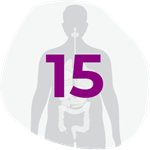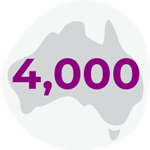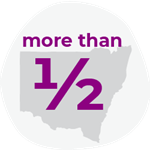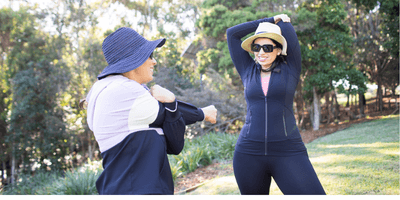Maintaining a healthy weight for you
A healthy weight is different for everyone and depends on your sex, age, height, muscle mass, biological and genetic factors, including ethnic background. Obesity is a medical term to describe extra body fat that affects a person's health.
Overweight and obesity is a complex health issue and is increasing in NSW. Obesity is not a personal judgement or a reflection of someone's character. Our built environment, the media and where we live, go to schools and work are some of the many influencing factors.
Research shows that more than 15 types of cancer are more common in people who experience overweight or obesity. While the evidence shows that the more weight gained as adults the higher the risk of postmenopausal breast cancer, its important to note that the more weight gained as young adults, the lower the risk of breast cancer. 1
Extra body fat, especially around the waist and vital organs (like the liver, kidneys and heart), leads to an increase in chemicals and hormones being released within the body. It may also lead to inflammation.2 This can alter how the cells in your body divide, which can increase the risk of cancer.
Eating a nutritious diet and doing regular exercise are essential habits to help you be healthy, regardless of body weight.
Talk to your doctor to get information specific to you and your situation.
Get the facts
Overweight and/or obesity can increase the risk of more than 15 types of cancer1
Almost 4,000 cancer cases in Australia each year are caused by overweight or obesity4
More than half of NSW adults experience overweight or obese3
More than 15 types of cancer are linked to weight
More than fifteen types of cancer are more common in people who are above a healthy weight.
These cancers include mouth and upper throat, larynx (voice box), oesophageal (food pipe), breast, liver, gallbladder, kidney, bowel (colon and rectum), multiple myeloma (a type of blood cancer), meningioma (a type of brain tumour), thyroid, gastric cardia (upper stomach), pancreatic, prostate, ovarian and uterine.5
The evidence shows that the more weight gained as adults the higher the risk of postmenopausal breast cancer, however its important to note that the more weight gained as young adults, the lower the risk of breast cancer.
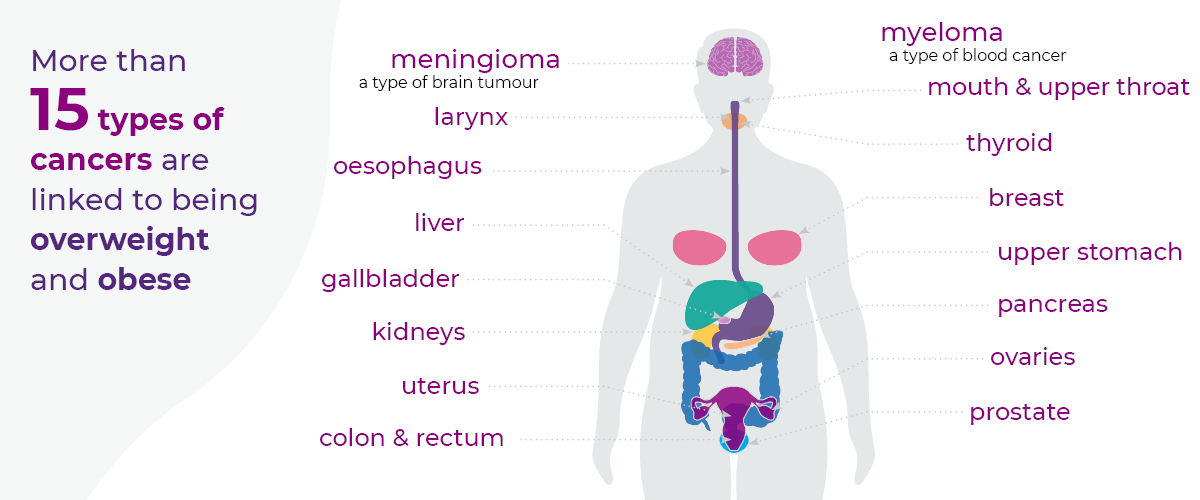
A healthy body weight for you
It’s important to understand what is a healthy weight for you, as this can differ greatly from person to person. Your body weight and waist measurement can provide some insight, but don’t always give a complete picture. Things like your lifestyle, ethnicity, genetics and your health history all influence what is a healthy weight range for you.
If you’re concerned about your weight, it’s best to talk to a doctor or dietitian. They can help you understand what a healthy weight is for you and guide you to make the best choices for your health. You can also contact the Get Healthy coaching service for support as you make healthy changes or ask your doctor to refer you.
Key Tip: Take a long term approach
Focusing on eating a balanced diet and being active will help you be healthy and feel good. A long-term approach to your health and wellbeing will help you reduce your risk of cancer.
Maintaining a healthy body weight for you can be challenging
It can be hard to know if you are taking the right steps to be as healthy as you can be.
Focusing on two key factors will help you: eating healthy and exercising regularly.
There are many other things you can do to reduce your cancer risk in the future. Get all the facts and discover our practical tips to live a healthier life.
Studies show us that about one in four cancer cases can potentially be prevented through improvements in diet and physical activity.[8]
More information and resources
- Get Healthy NSW offers free health coaching over the phone to help you reach your health goals.
- Healthy Eating Active Living is a NSW Government website with healthy eating tips and information on free programs to get you active. It aims to help you live a healthier life through food and exercise.
- The Australian Dietary Guidelines tell you what foods to eat and how much. They also tell you what foods to avoid.
- Learn about the Obesity Collective who are working toward healthy communities that prioritise health and wellbeing, and where weight and obesity are treated as collective responsibilities – free from stigma and shame.
- Australia’s Physical activity and sedentary behaviour guidelines tell you how much exercise you should do each day. They also give tips on how you can get started.
- The Staying well and preventing cancer flipchart was developed for community educators supporting multicultural communities. It starts the conversation around cancer prevention and healthy living behaviours including healthy eating, being active, being a healthy body weight for you, not smoking, protecting your skin and participating in cancer screening.
Related pages
1. Recalde, M., Pistillo, A., Davila-Batista, V. et al. (2023) Longitudinal body mass index and cancer risk: a cohort study of 2.6 million Catalan adults. Nat Commun 14, 3816. https://doi.org/10.1038/s41467-023-39282-y
2. Ellulu, M. S., Patimah, I., Khaza'ai, H., Rahmat, A., & Abed, Y. (2017). Obesity and inflammation: the linking mechanism and the complications. Archives of medical science : AMS, 13(4), 851–863. https://doi.org/10.5114/aoms.2016.58928
3. NSW Government. Snapshot November 2018: Adult overweight and obesity. Available at https://www.health.nsw.gov.au/heal/Publications/adult-obesity-snapshot.pdf Accessed 17 August 2020)
4. Kendall, B. J., Wilson, L. F., Olsen, C. M., Webb, P. M., Neale, R. E., Bain, C. J., & Whiteman, D. C. (2015). Cancers in Australia in 2010 attributable to overweight and obesity. Australian and New Zealand journal of public health, 39(5), 452–457. https://doi.org/10.1111/1753-6405.12458
5. World Cancer Research Fund Australian Institute for Cancer Research. Diet, Nutrition, Physical Activity and Cancer: a Global Perspective. Continuous Update Project Exert Report 2018. Available from dietandcancerreport.org
6. Estimating the future burden of cancers preventable by better diet and physical activity in Australia, Peter D Baade, Xingqiong Meng, Craig Sinclair and Philippa Youl. Med J Aust 2012; 196 (5): 337-340. || doi: 10.5694/mja11.11082. Published online: 19 March 2012: https://www.mja.com.au/journal/2012/196/5/estimating-future-burden-cancers-preventable-better-diet-and-physical-activity
